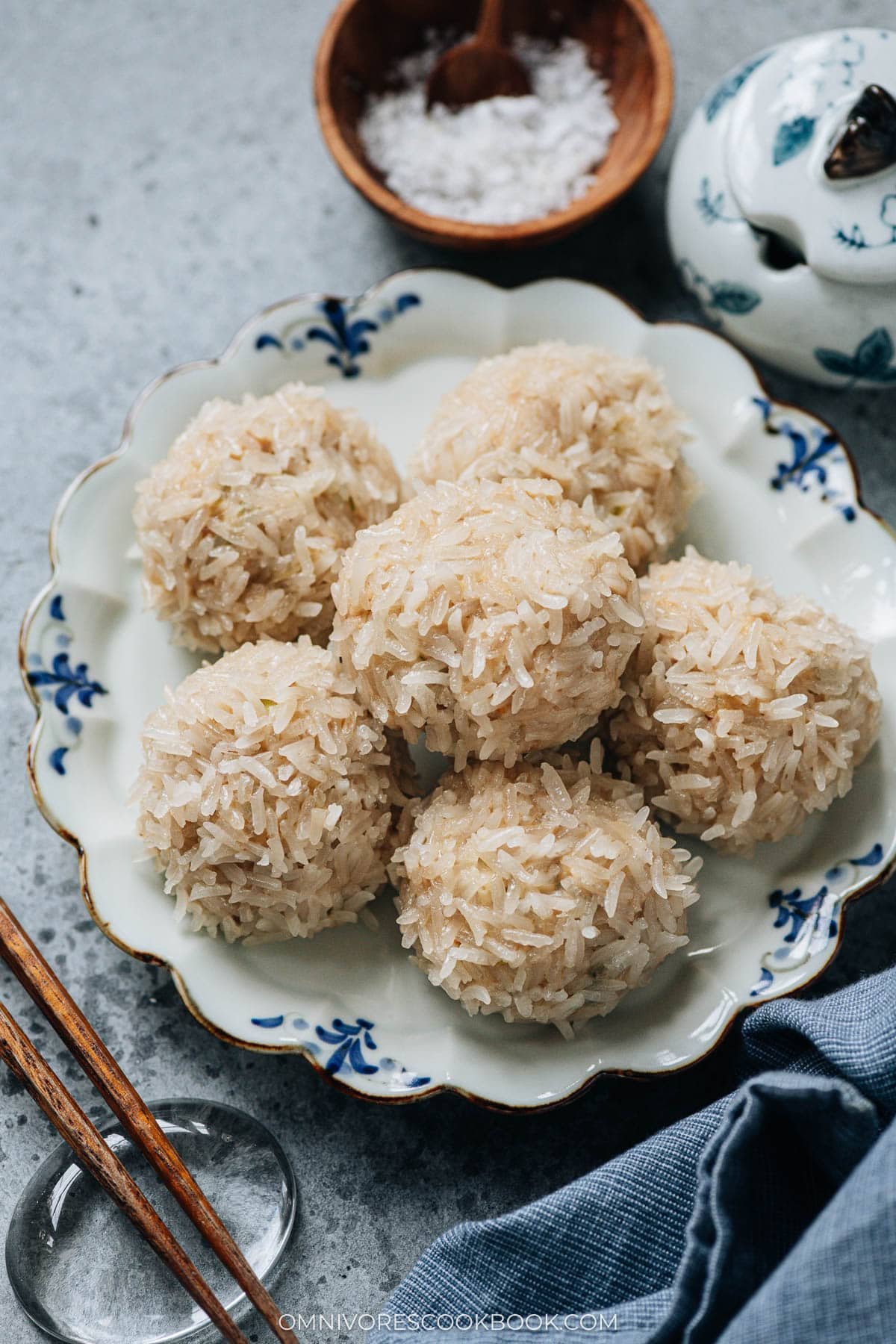
Some of my favorite childhood memories revolve around Chinese homestyle dishes you might not find in a restaurant. My grandma was a great cook. Her lion’s head meatballs, braised pork feet, and lamb dumplings make a great feast. One of her masterpieces was pearl balls (珍珠丸子), or Zhen Zhu Wan Zi. The pork meatballs are coated in glutinous rice and steamed until the rice becomes translucent. They are tender and juicy, rich in flavor, comforting in texture, and always worth the careful work.
What Are Pearl Balls?
Pearl balls are a classic Chinese dish consisting of seasoned pork meatballs coated in soaked sticky rice, then steamed. The rice grains cling to the meat, absorbing the juices and giving the balls a “pearl-like” appearance, hence the name. They are sometimes called “snow meatballs” because of the way the rice looks after steaming.
While often served as a main dish at family meals and during Chinese New Year, every bite brings together savory pork, fragrant dried shrimp, aromatic ginger and scallion, and a subtle sweetness from the rice and seasonings.
Ingredients
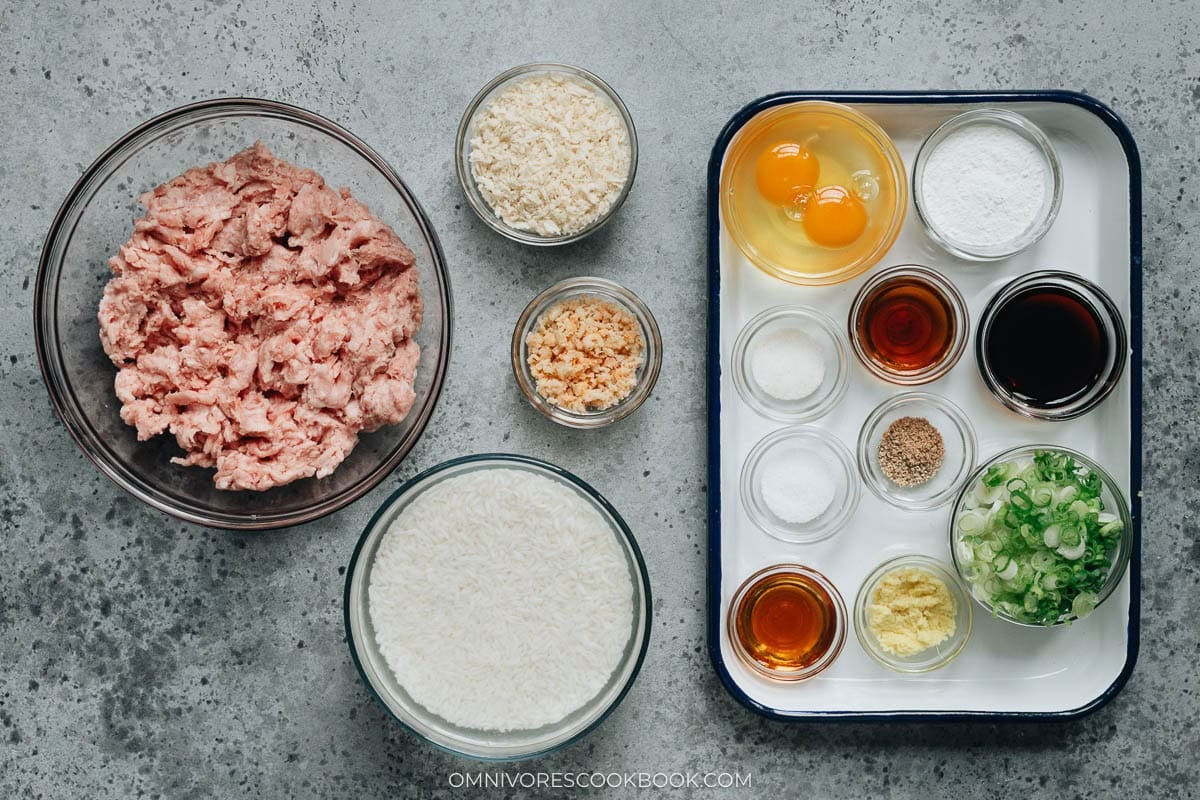
Glutinous rice
Glutinous rice is also called sticky rice, sweet rice, and mochi rice. Once cooked, it becomes very tender and has a sticky texture. You can find glutinous rice at Asian markets, and even at some regular supermarkets. In this recipe, I used Thai glutinous rice, which is a long grain type. But Japanese short grain glutinous rice also works.
Chinese dried shrimp
Chinese dried shrimp (海米) are an optional ingredient in this recipe but I highly recommend it if you can get your hands on some. These dried shrimp are umami bombs and a small amount of them adds great depth of flavor to the dish. Compared to fresh shrimp, they are saltier and have a concentrated taste of the sea. You can usually find them in Chinese markets.
On the other hand, you can also consider swapping out 4 ounces (115 g) of pork and replacing it with chopped fresh shrimp. That will add a lot of great flavor to the meatballs as well.
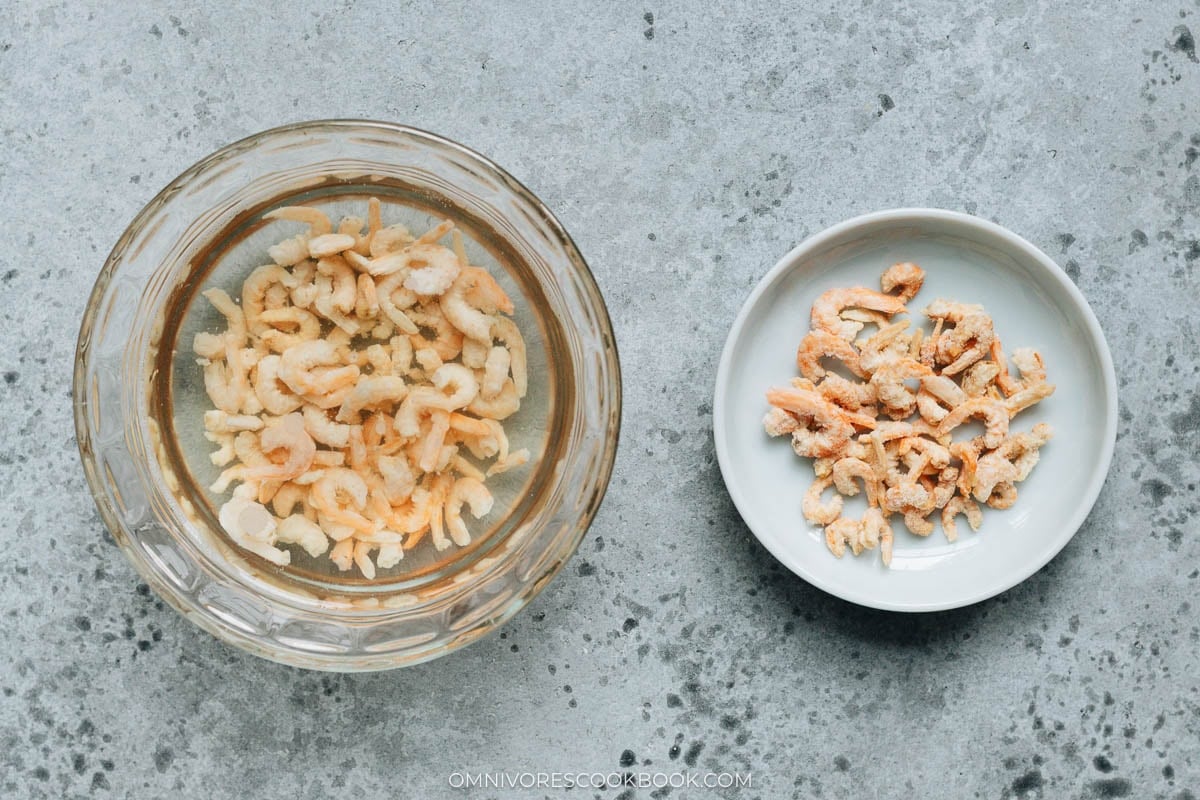
Cornstarch & panko breadcrumbs
Cornstarch helps bind the meat and keeps the texture of the meatballs tender. Panko breadcrumbs are another binder that gives the meatballs structure. If you find the meatballs hard to shape and too soft, you can add a little more panko breadcrumbs to help with the shaping.
Seasonings
Chinese pearl balls use a lot of seasonings and spices. Soy sauce, Shaoxing wine, ginger, scallion, white pepper, nutmeg and sesame oil build layers of flavor. The meatballs are designed to be enjoyed by themselves without a dipping sauce. The right amount of seasoning will bring out the flavor of the pork without overwhelming it.
How to make
- Soak ahead: Soak the glutinous rice and dried shrimp in separate bowls, covered with water, in the refrigerator for at least 4 hours, up to overnight. This softens both and brings out more aroma. The long soak is crucial to make the glutinous rice tender after cooking. Once soaked, drain the glutinous rice thoroughly.
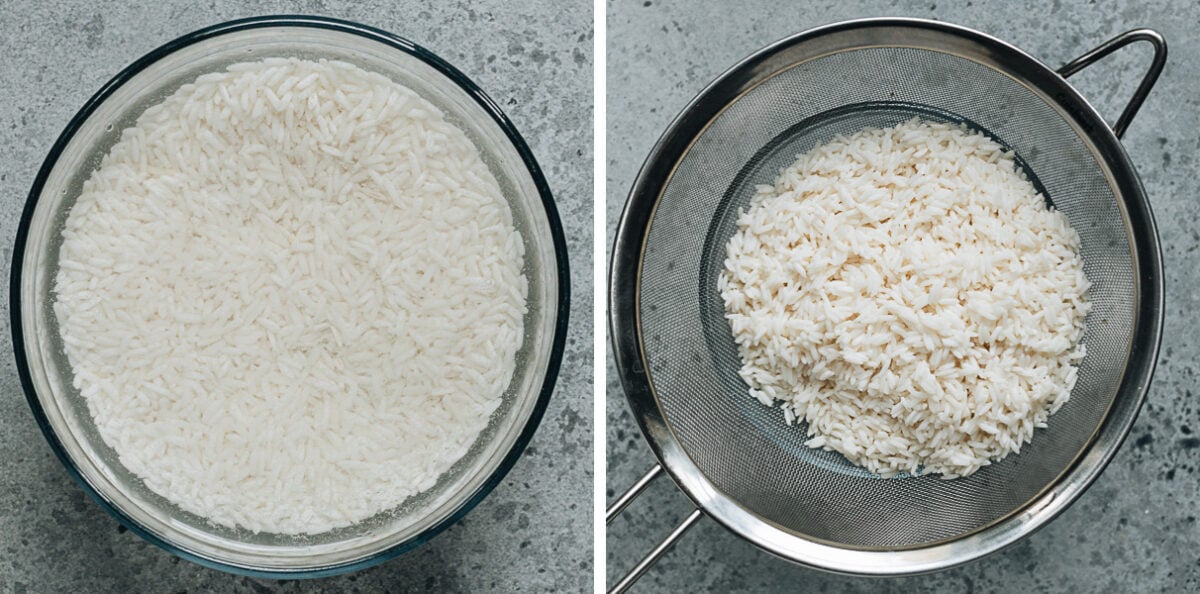
- To prepare the meatball mixture: beat all the seasonings together until the meat is sticky. This step is very important to make sure the liquid is fully absorbed, and the pork has structure. If not beaten long enough, the meatballs will be soft and hard to shape.
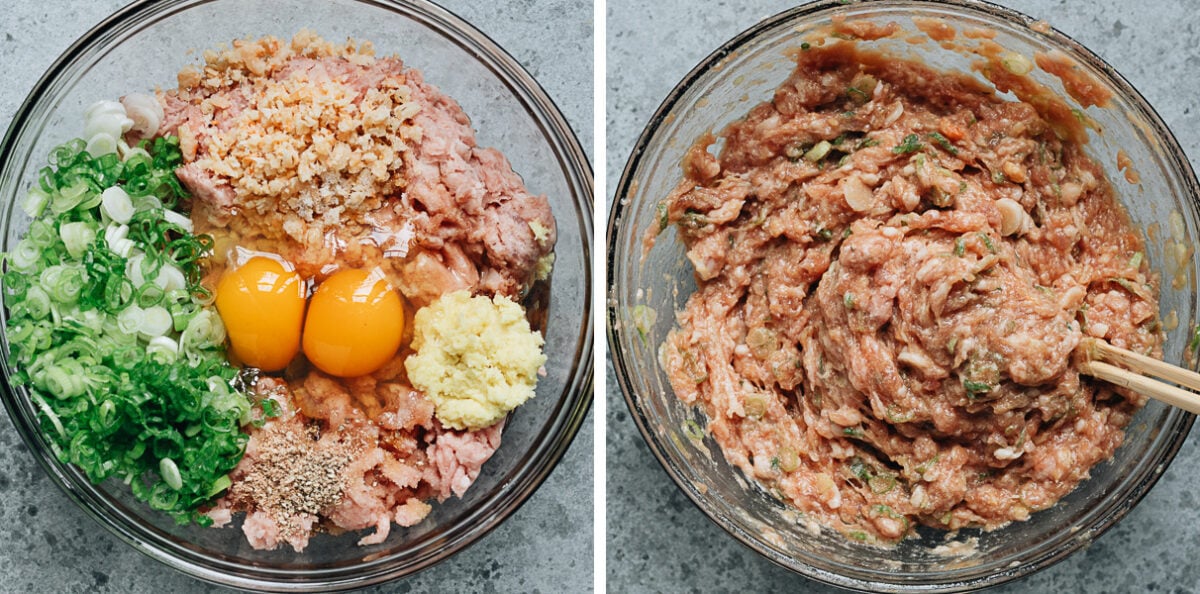
- Then you can blend in the cornstarch and breadcrumbs. The mixture will become stiffer and easier to shape. If you notice the mixture is still too runny to shape, you can use more breadcrumbs at this stage.
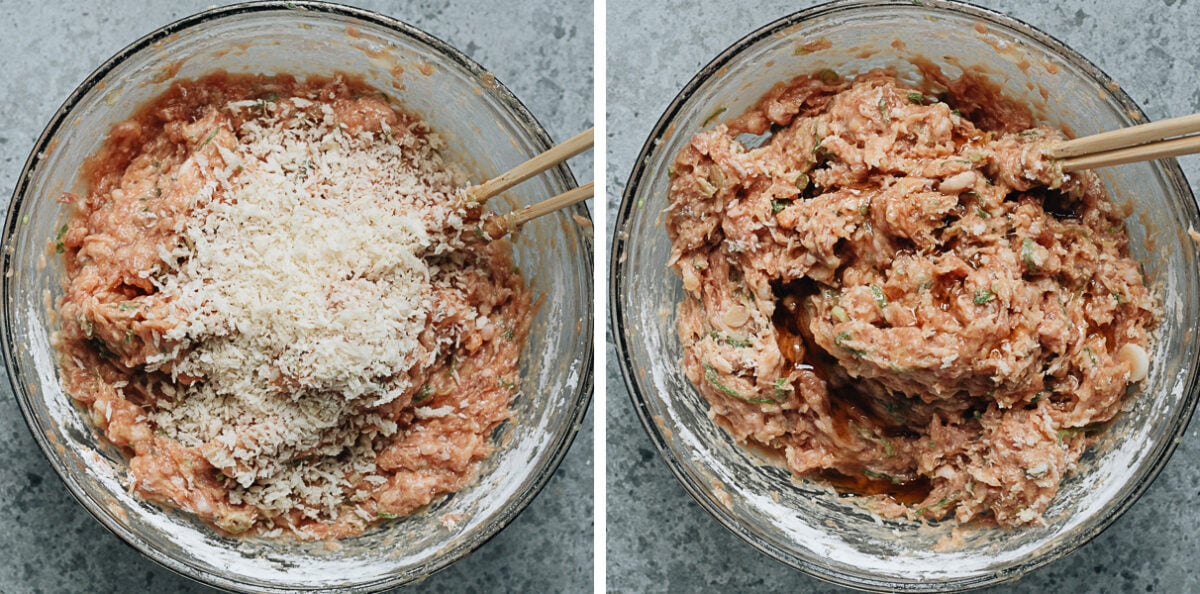
- To prepare the steamer: I prefer to line my steamer with parchment paper. To prepare the parchment, cut the paper into a large circle that will fit into your steamer. Fold it a few times, then cut small holes in it. This allows the steam to come through and cook the meatballs. Alternatively, you can use a few layers of wet cheesecloth as the liner. Another great way is to use vegetables like a dim sum restaurant would – slice carrots thin, and place one slice under each meatball.

- To shape the meatballs: I prefer to use a 2-tablespoon cookie scoop to portion out the pork and directly add it to the plate of glutinous rice. Roll the meatballs in the rice to coat well. Then gently press the rice so it sticks.

- Place the assembled pearl balls onto the lined steamer, making sure there’s some space in between. The meatballs will expand as they cook.
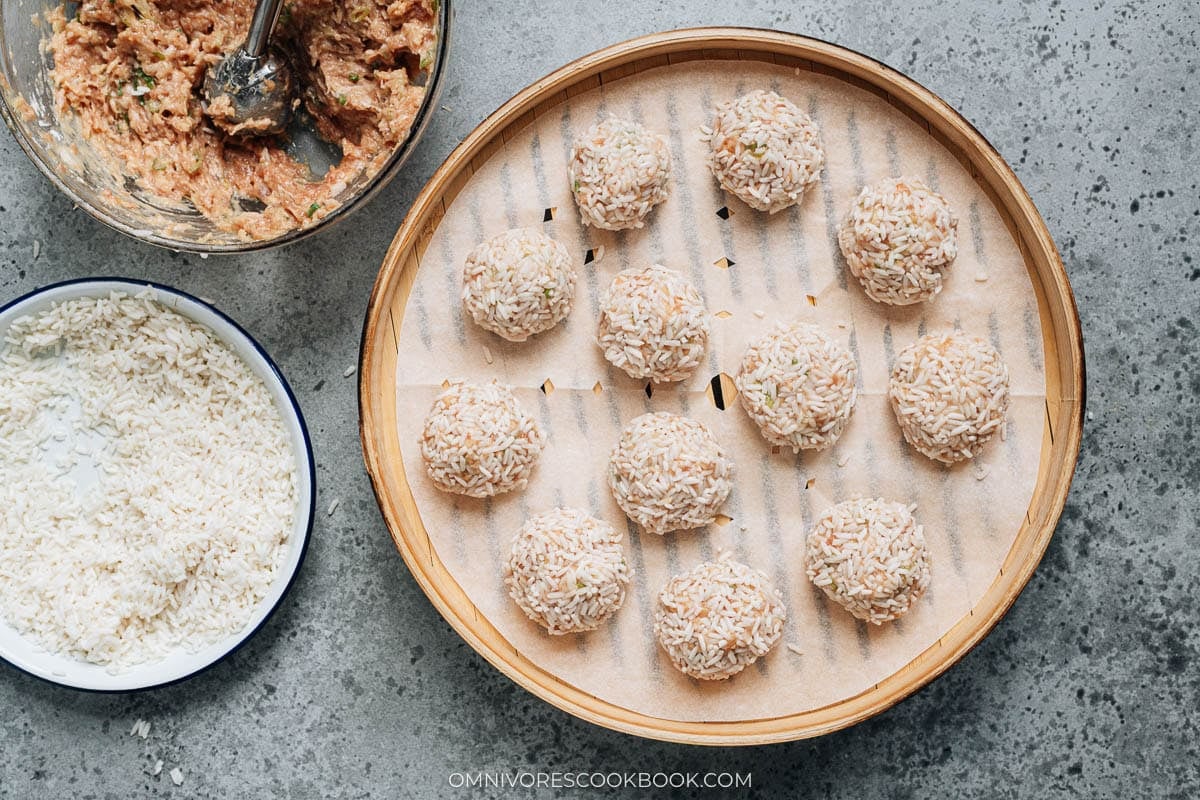
- To cook: The quickest way is to set up double bamboo steamers (12″) over a wok, so you can cook all the meatballs in one batch. If you use a steamer pot, you will need to cook them in two batches. I usually like to cook one batch while assembling the rest of the meatballs.
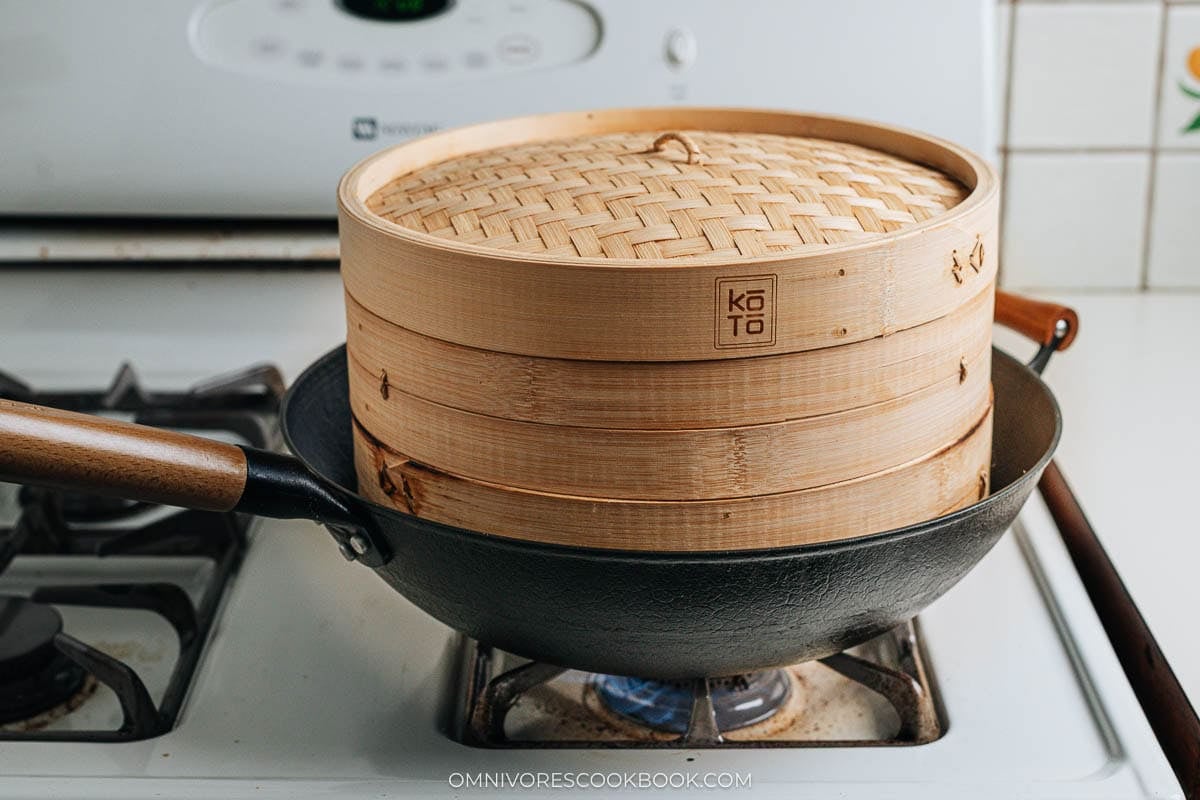
Once cooked, the meatballs are juicy and tender. The glutinous rice will have soaked up the juice from the pork and become semi-transparent. The rice will have a mild sweet taste that works so well with the savory pork.
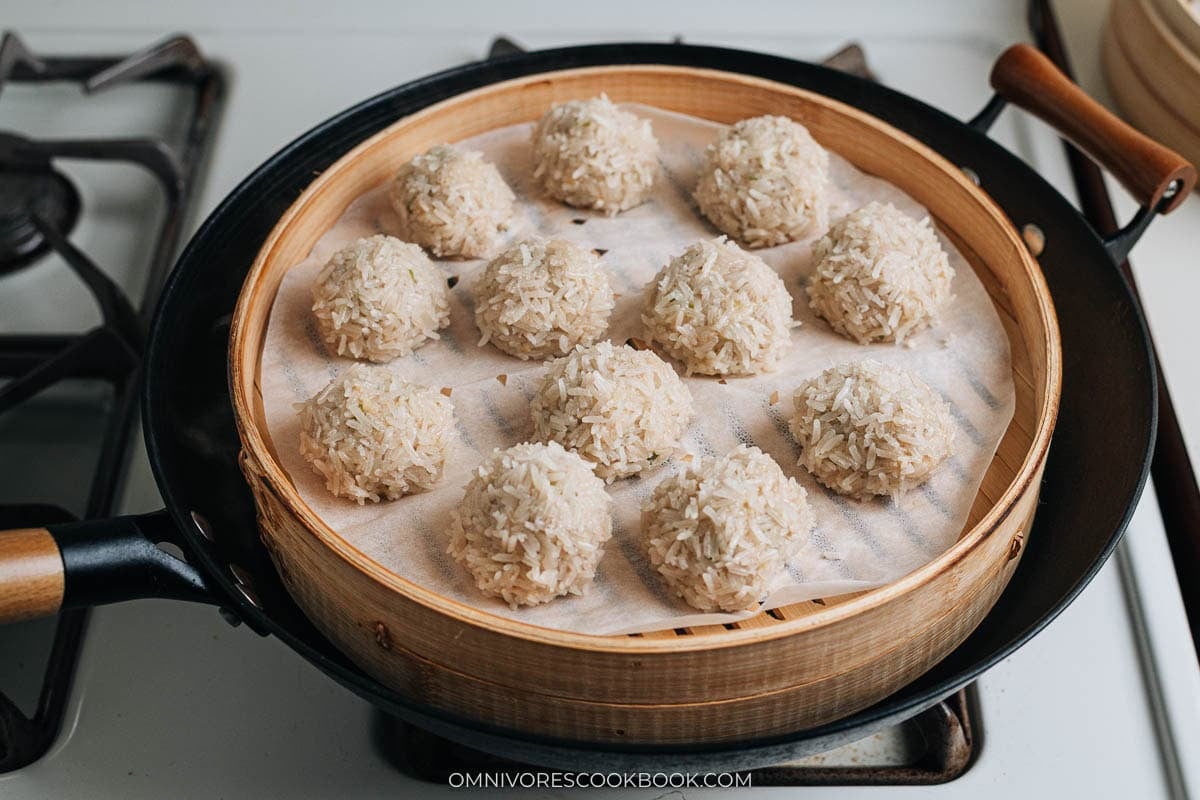
Serve and store
Serve the meatballs as a main dish, with or without rice. In my family, no sauce is needed because the meatballs are flavorful enough. But if you like, a simple dipping sauce (soy + vinegar + sesame oil) or a squeeze of hot sauce works well.
Leftovers can be refrigerated for up to four days or frozen for a few months. These meatballs are great for meal prep because they freeze so well. Thaw them in the fridge overnight before reheating. Reheat by steaming to maintain moisture. Microwaving works too, if you add a drop of water and cover the meatballs with a wet paper towel.
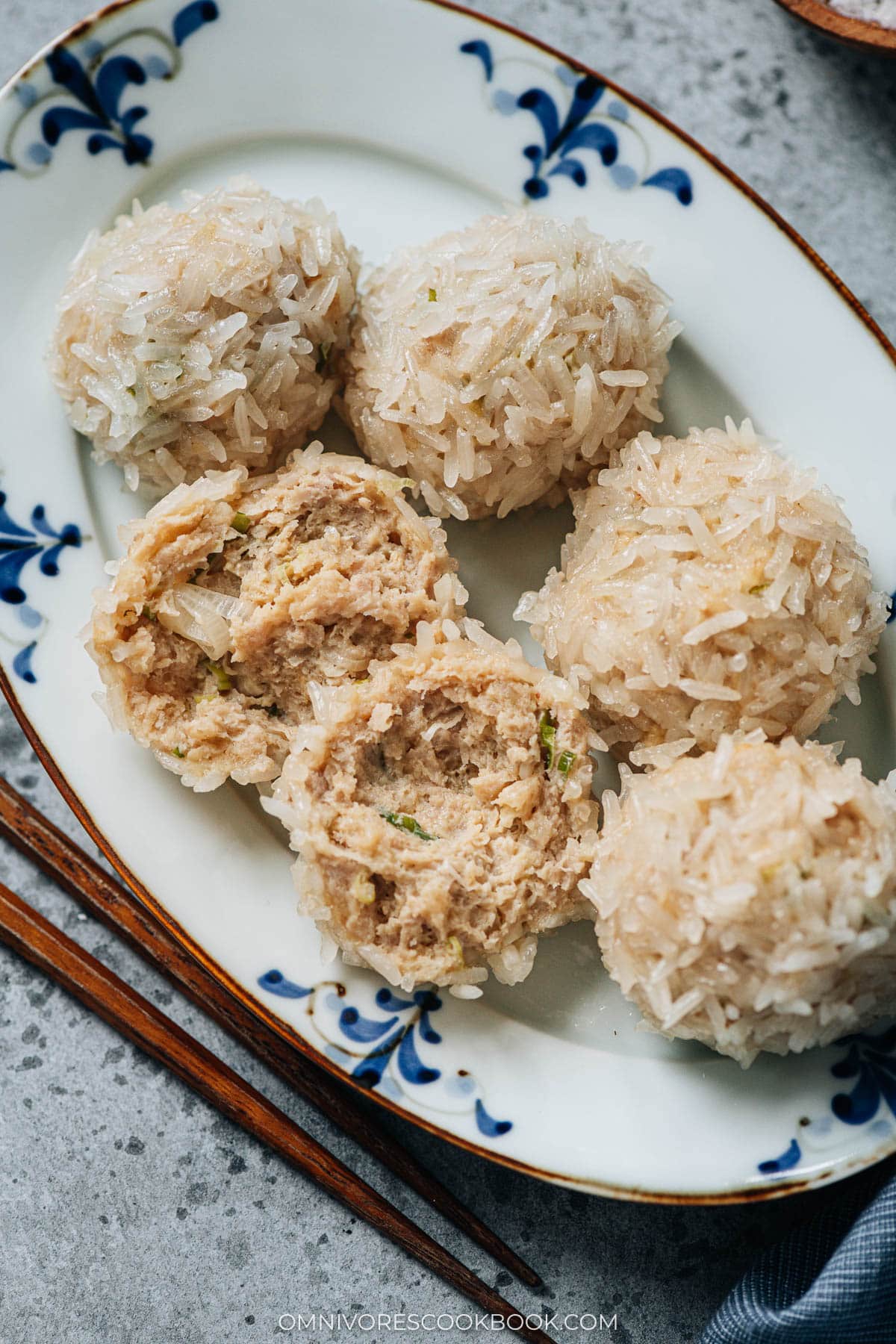
Frequently asked questions
Can I use regular rice?
Glutinous rice (also called sticky rice or sweet rice) is required to make authentic tasting pearl balls. Regular white rice won’t cling properly and won’t give the chewy, pearly texture that defines the dish.
Why is my rice too hard after steaming?
That usually means the rice wasn’t soaked long enough. You should soak it for at least 4 hours. Also check your steamer setup. Make sure you have a liner (see the blog post for more info) that lets the steam come through properly.
Can I substitute other meats for the pork?
I don’t recommend it, but you can if you want. Pork works the best for pearl balls because it is quite fatty, which creates a juicy and tender texture. Its flavor is also relatively mild, which pairs well with the slightly sweet glutinous rice. While ground chicken is even milder, the meat is a little too lean, which results in tougher meatballs. The sticky rice also won’t get enough fat from the meat, resulting in a slightly drier texture. While ground beef is fattier (make sure you use the 80% lean or a fattier mix), the flavor is quite strong and will change the flavor profile of the dish.
More homestyle dishes you might like
- Stuffed Tofu (囊豆腐)
- Chinese Braised Chicken with Mushroom (小鸡炖蘑菇)
- Pork and Corn Soup (猪肉玉米汤)
- Eggplant with Tomato (西红柿炒茄子)
- Chinese Chive and Egg (韭菜炒鸡蛋)
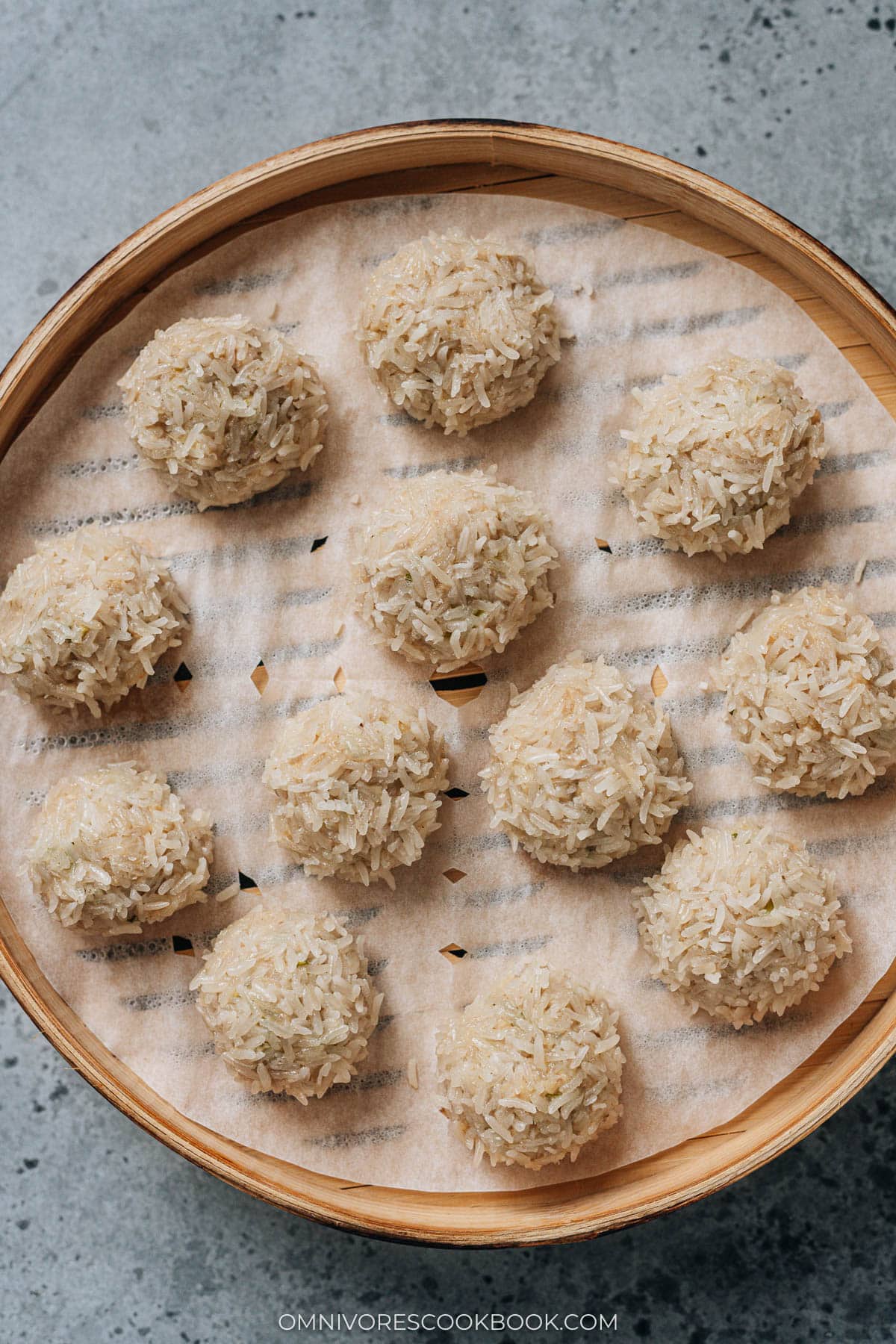
Chinese Cooking Made Easy
Are you new to this website? This free email series is a great place to start. I’ll walk you through a few of my most popular recipes and show you how and why they work. You’ll quickly start to cook better Chinese food in your own kitchen.
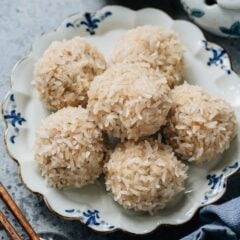
Chinese Pearl Balls (珍珠丸子)
Ingredients
- 1 cup glutinous rice
- 2 tablespoons Chinese dried shrimp (optional)
- 1 lb ground pork (*Footnote 1)
- 2 eggs
- 2 tablespoons light soy sauce
- 1 tablespoon Shaoxing wine
- 2 teaspoons ginger , grated
- 4 green onions , thinly sliced
- 1 teaspoon sugar
- 1 teaspoon salt
- 1/4 teaspoon white pepper powder
- 1/4 teaspoon nutmeg powder
- 2 tablespoons cornstarch
- 1/2 cup panko breadcrumbs
- 1 tablespoon toasted sesame oil
Instructions
- Add glutinous rice and dried shrimp into separate bowls. Add cold water to cover. Let soak for at least 4 hours. (*Footnote 2)
- Drain glutinous rice and dried shrimp. Place the glutinous rice onto a medium plate with rim or a large bowl. Finely mince the rehydrated dried shrimp.
- Combine pork, eggs, dried shrimp, light soy sauce, Shaoxing wine, ginger, green onion, sugar, salt, white pepper, and nutmeg in a large bowl. Stir in one direction, in a circular motion until it’s sticky. Add cornstarch and panko breadcrumbs. Stir to mix well. Pour in the sesame oil. Stir again to combine.
- Line your steamer with parchment paper with holes cut in it, or a few layers of wet cheesecloth.
- Scoop out about 2 tablespoons of meat paste (you can use a cookie scoop), shape it into a ball, and roll it in the glutinous rice, until the surface is completely coated with rice. Gently press with your hand so that the rice sticks to it. Place meatballs onto the lined steamer. Make the rest of the meatballs using the same method, spaced 1” (2.5 cm) apart.
- Add 2” (5 cm) water to a steamer and bring it to a boil.
- Steam the meatballs for 15 minutes, or until cooked through (*Footnote 3). Serve as a main dish with or without rice (*Footnote 4).
Notes
- A higher fat content makes the meatballs very juicy and tender. If you have access to a Chinese market, coarsely chopped ground pork works even better. On the other hand, leaner ground pork produces slightly firmer meatballs but the texture will be silky and nice as well.
- Soaking for less time will result in chewier rice. You might be able to get away with 2 hours soaking, but 4 hours produces the best result. You can soak both overnight in the fridge as well.
- You might need to steam the meatballs in two batches unless you’re using a two-tier bamboo steamer, stacked together. Once you’ve shaped the first batch of meatballs, you can steam them while shaping the second batch.
- This dish is intended to be served without sauce. You also serve it with sriracha or a dumpling dipping sauce (1 tablespoon Chinkiang vinegar + 2 teaspoons soy sauce + 1/2 teaspoon sugar + 1/2 teaspoon sesame oil).
- To make this dish gluten-free: use tamari to replace soy sauce, use dry sherry to replace Shaoxing wine, and make sure to use gluten-free panko breadcrumbs.
Nutrition

Did you make this recipe?
I’d love to hear how it turned out for you! Please take a moment to leave a 5-star rating ⭐️ and share your thoughts in the comments further down the page. It really helps others discover the recipe too.

Iris
I have just made it for the Mid Autumn Festival dinner. Though I know it may not be authentic, I would add chopped water chestnuts into the meat balls next time for the crunchy texture.
Thank you for the recipe.
Maggie Zhu
Adding chopped water chestnuts is definitely OK! It’s quite common in Chinese meatballs. I’m glad to hear you enjoyed the dish and thanks for leaving a positive review 🙂
Eddie Koh
Can these be frozen before cooking? Perhaps, they can be cooked in their frozen state: with longer cooking times?
Maggie Zhu
I think you totally can. My only concern is, the meatballs are quite tender when it’s in the raw form. So make sure you place them on a tray with a little space in between, so they won’t be smashed. I have not tried it myself so not sure about the cooking time. I would start checking at 20 minutes mark, using a thermometer if possible, until the temperature register 165F.
Cana
I’m using two lbs of pork to make this for an event. That’s 8 egg whites and it looks like waaaay too much! Is this right?? Other recipes call for 1 egg for 1 lb of meat. This one seems the most authentic so I wanted to use it, but have over a full cup of egg whites at this point. So just checking. If you respond within the hour I will wait to add it last. if not, I guess I’ll just put it all in!
Rebecca
Thank you! I tried making these by what my Chinese friend told me but I couldn’t figure out what to put in the mix to make the meat more firm. Anyway, now I know what I can use. I know I am on the right track now!
Maggie
Glad to hear the recipe is helpful Rebecca! Happy cooking and hope your dish turns out great 🙂
Rick Carrington
Hi Maggie,
This looks fantastic and I”ve got the ingredients ready to go.
I do wonder. I’ve also had a shrimp version of this in a few dim sum places here in SF. Made with fresh shrimp, no pork in them. I assume that the recipe would be similar but I wonder about adding a bit of pork fat or other ingredient to make it hold together.
Any ideas
Rick
Maggie
Hi Rick, happy to hear that you decided to try out my recipe!
For the shrimp version, yes, adding some pork fat or ground pork (and maybe a bit cornstarch) will help holding the shrimp together. I have a Cantonese wonton recipe that uses the same idea to create a shrimp filling: https://omnivorescookbook.com/cantonese-wonton-noodle-soup
I’ve never tried shrimp pearl balls but it sounds so delicious!
Happy cooking and let me know how the dish turns out 🙂
Diana Fox
Aloha Maggie, I Had to pick up shrimp the day I made the recipe, so I put the dry shrimp in the food processor before I soaked them. This helped shorten the soaking time. Then I used a strainer to drain off the water. I took them to a neighbors and they enjoyed them.
Shauna
so easy to make! such a huge hit with our big parties (i doubled the recipe for 20+ ppl). so awesome. thank u so much!
Maggie
Hi Shauna, wow, I’m so glad to hear you cooked this dish for such a large crowd! You just made my day 🙂 Thanks for taking time and letting me know!
Have a great week ahead!
Sheryl
What do you think about subbing potatoe starch in place for cornstarch or tapioca starch?(I have those on hand…) I can’t wait to make this!!
Maggie
Hi Sheryl, please feel free to use cornstarch or tapioca starch to replace the potato starch. I have tried them all and I don’t see a big difference.
Happy cooking and let me know how the dish turns out! 🙂
Kiem
I used ground turkey and 2 Chinese sausages
I stir fried some vegetables, added oyster sauce and some water
Then added the already steamed rice balls
Let the vegetables cook until tender
It made a complete meal
4 meatballs per serving
I might consider making the balls smaller and double the rice to get more rice in the dish
Maggie Zhu
Hi Kiem, I’m glad to hear you enjoyed the dish and thanks for leaving a positive review! It sounds like a great way to serve these meatballs.
For meatball size – smaller ones definitely work well! Depending on how small they are, you might want to slightly reduce cooking time so they won’t be overcooked.
Marissa | Pinch and Swirl
Why is it that every time you post something I get the same thought in my head – “I have to make this!!!!” These look wonderful, Maggie. Always love your posts…
Maggie
Glad to hear you like this one Marissa! These are so easy to make once you try it 🙂
Robyn @ Simply Fresh Dinners
You always make your recipes look like a breeze to make, Maggie, so inspirational! These look so delicious and I would have trouble stopping after a few. Shrimp, rice and pork is a match made in heaven! Great photos, too 🙂
Maggie
Yep, shrimp and pork are the best combo! I didn’t know these are so easy to make before I tried them! lol
Kevin | Keviniscooking
Wow, this is a good one and I so love these, too! Wish I had a grandmother who made me these… mine always overcooked the veggies until they were DEAD and made Irish dishes which were usually pretty bland. She tried! Liking the videos, nice job Maggie and thanks for this recipe! Pinned 🙂
Maggie
Unfortunately she never really taught me how to cook these, because she only passes her treasure recipes to the boys in the family. lol She taught my mom the general cooking process, but my mom never managed to replicate the whole thing. So this is still not the original best flavor I had when I was a kid. I’m pretty sure she used to grind meat herself, and use very fatty part to make the meatballs. I used pork with 20% fat, but it’s still not fatty enough. Although I’d keep the recipe this way, so I can cook it more often without worrying a heart attack. lol
Thanks for sharing Kevin. Happy Chinese New Year!